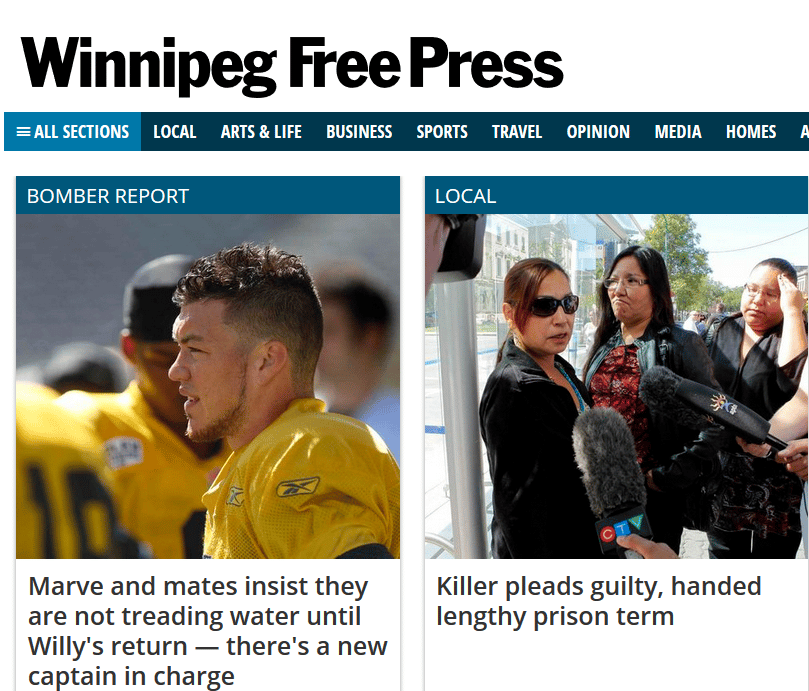
Winnipeg Free Press Reports Results One Year into Micropayment Strategy
Lorem ipsum dolor sit amet, consectetur adipiscing elit. Ut elit tellus, luctus nec ullamcorper mattis, pulvinar dapibus leo.
One year after adding micropayments to their tiered revenue strategy, the Winnipeg Free Press reports success, reports J Source. Publisher Bob Cox offered an update on the project at the Newspapers Canada 2016 National Conference at the end of May.
According to J Source, Cox gave the following stats for the Winnipeg Free Press at the conference:
- 200,000 registered accounts
- 35,000 paid digital readers, including 27,000 print subscribers
- 8,500 read-now-pay-later or all-access-digital subscribers
- 1,000 articles sold daily at $0.27 Canadian dollars (about $0.21 in U.S. dollars)
- 265,000 articles sold since July 1, 2015 (revenue of $71,550 Canadian)
- 2,531 refunds on articles issued, less than 1 percent of articles purchased
Source: Winnipeg Free Press

Earlier this year, we wrote an in-depth piece about the Winnipeg Free Press’s new business model which was designed to appeal to three different types of readers: one-and-done who don’t want to register and only want to read the occasional article, returning readers who may not hit the maximum number of free articles each month but who will come back for more, and loyalists who read hundreds of articles per month.
Once the transition began in July last year, readers could access three free articles per month. After that, they must become subscribers or pay per article read. An all access digital subscription is $16.99 a month, or subscribers can combine print and digital at $25.42 per month for Monday through Saturday print delivery plus all digital access, or $16.99 per month for Saturday-only delivery plus all digital access. [Prices quoted are in Canadian dollars.]
After a reader access their three free articles in a given month, they are asked to register for a one-month free trial. At that point, the Winnipeg Free Press tracks their online activity and lets readers know what they would have paid for that month if they were read-now-pay-later customers. Then at the end of the free month, the Winnipeg Free Press gives those readers options – subscription or read-now-pay-later. The breakeven point is around 63 articles. Readers who read more than 63 articles a month will save money by subscribing.
For readers who select the read-now-pay-later option, readers consume as many articles as they want in a month and the newspaper keeps a running tally of articles. Customers are then charged at month end for those articles. If the customer reads an article they don’t like, they can get a refund. No questions asked.
The rationale behind this multi-tiered strategy is that the newspaper is addressing different audiences in ways that work best for each, removing barriers to the Winnipeg Free Press’s content. One-and-done customers can read their three free articles and stop, repeat users can subscribe or do read-now-pay-later, and loyalists can subscribe. The micropayment strategy was designed to work in concert with subscriptions, not to compete against them.
“It would never work on its own. One article at a time isn’t going to keep your paper alive. It’s part of our strategy to build our subscriber base and an engaged audience,” Cox said at the conference. “From a micropayment point of view, we opened a door. Our hope is that we can keep that door open and enrich that relationship with them.”
Cox noted one particular challenge at the conference – quelling advertiser fears that the change would not impact their ad space or reader base. The paper has helped overcome that by educating its advertisers, says J Source.
Insider Take
Is this new strategy working? Cox reports that readers are more engaged and that digital readership is growing, so there are positives. However, micropayments alone will not sustain the newspaper, especially if they generated just $71,550 in the first year. In related news, in March, the Winnipeg Free Press started a workforce reduction “due to economic downturn.” So while the new strategy is helping turn things around, the bottom line has not shifted enough to prevent staff layoffs.
Why? The Winnipeg Free Press is facing the same challenges as the rest of the publishing industry – trying to offset print revenue and advertising declines with innovative business models and growing digital revenue. After speaking in depth with Christian Panson, vice president of digital at Winnipeg Free Press, we believe the newspaper is utilizing all of its resources – and a considerable amount of data, study and research – to make smart business decisions about the changes it needs to make.
This new model may take some time to reverse declining revenue, but the Winnipeg Free Press has made well-informed decisions in formulating their strategy, and they are nimble. Panson and his team follow the data and make adjustments as needed, giving the newspaper more flexibility than it has had in its 143-year history. We hope they’ll be able to make this work, as it could serve as a model for change for other subscription publishers.




